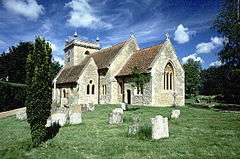Stadhampton
| Stadhampton | |
 St. John the Baptist parish church |
|
 Stadhampton |
|
| Area | 9.80 km2 (3.78 sq mi) |
|---|---|
| Population | 832 (parish, including Chiselhampton, Brookhampton and Ascott) (2011 Census) |
| – density | 85/km2 (220/sq mi) |
| OS grid reference | SU6097 |
| Civil parish | Stadhampton |
| District | South Oxfordshire |
| Shire county | Oxfordshire |
| Region | South East |
| Country | England |
| Sovereign state | United Kingdom |
| Post town | OXFORD |
| Postcode district | OX44 |
| Dialling code | 01865 |
| Police | Thames Valley |
| Fire | Oxfordshire |
| Ambulance | South Central |
| EU Parliament | South East England |
| UK Parliament | Henley |
| Website | Stadhampton Grapevine |
|
|
Coordinates: 51°40′52″N 1°07′52″W / 51.681°N 1.131°W
Stadhampton is a village and civil parish about 5 miles (8 km) north of Wallingford, in South Oxfordshire, England. Stadhampton village is on the A329 road and close to the River Thame.
Location
The parish is about 10 miles (16 km) south-east of Oxford and includes the villages of Stadhampton and Chiselhampton and hamlets of Brookhampton and Ascott. The 2011 Census recorded the parish's population as 832.[1]
The River Thame flows through Chiselhampton. Stadhampton and Brookhampton are separated by a brook that flows through Chalgrove and joins the Thame just above Chiselhampton Bridge. Northwest of Chiselhampton is Richmond Hill, whose summit is more than 279 feet (85 m) above sea level.
Toponym
The toponymy Stadhampton derives from Stodham or Stadham. The short form of the name is still sometimes used. Stodham is the more likely of these two derivatives: in Old English "Stod" was a stallion and "ham" referred to a home or farm. It is also possible that "Stod" is a proper name taken from the original owner of the farm as is the case with the nearby villages of "Witta's Farm" (Long & Little Wittenham).
Parish church
The Church of England parish church of Saint John the Baptist dates from the 13th century and was rebuilt and enlarged by the Gothic Revival architect E.G. Bruton in 1875.[2] Since the Reformation St. John's has always had the same parish clergy as St. Mary's, Chiselhampton. The Welsh clergyman and writer John Roberts was priest of both parishes 1798–1803.
The tower has a ring of four bells. Henry I Knight of Reading, Berkshire cast the treble and second bells in 1621.[3] Mears and Stainbank of the Whitechapel Bell Foundry cast the third bell in 1883 and the tenor bell in 1884.[3] For technical reasons the bells are currently unringable.[3]
Economic and social history
In the 18th century Stadhampton had two clockmakers: James Jordan (born about 1751) and Thomas Jordan, who worked together.[4] Thomas repaired the turret clock at St Peter's parish church, Great Haseley on several occasions between 1770 and 1790.[4][5]
The village includes several buildings of architectural interest, including a number that are Grade II listed. The former Black Horse public house on Thame Road was built in 1751.[6] Ash Cottage in School Lane is formed from three former cottages dating from the 17th century, now a single house. On the main street is a 17th-century bakehouse, thatched and built of coursed stone and bearing the date 1658, that was used as a bakery until about 1914.[7]
Amenities

Most of the amenities of the parish are in the village, including Stadhampton Primary School.[8] Stadhampton village school used to be at the bottom of School Lane but is now in Cratlands Close.
The parish has three pub-restaurants: The Coach & Horses Inn[9] in Chiselhampton and The Crown[10] and the Crazy Bear Hotel[11] in Stadhampton. Stadhampton has a village store and post office at the petrol station.
Oxfordshire Animal Sanctuary is in Stadhampton.[12]
Sources
- Beeson, C.F.C. (1989) [1962]. Simcock, A.V., ed. Clockmaking in Oxfordshire 1400–1850 (3rd ed.). Oxford: Museum of the History of Science. p. 116 0. ISBN 0-903364-06-9.
- Lobel, Mary D, ed. (1962). A History of the County of Oxford: Volume 7: Thame and Dorchester Hundreds. Victoria County History. pp. 81–92.
- Sherwood, Jennifer; Pevsner, Nikolaus (1974). Oxfordshire. The Buildings of England. Harmondsworth: Penguin Books. p. 776. ISBN 0-14-071045-0.
References
- ↑ "Area: Stadhampton (Parish): Key Figures for 2011 Census: Key Statistics". Neighbourhood Statistics. Office for National Statistics. Retrieved 1 July 2016.
- ↑ Sherwood & Pevsner 1974, p. 776.
- 1 2 3 Walker, Mark (26 November 2006). "Stadhampton S John Bapt". Dove's Guide for Church Bell Ringers. Central Council of Church Bell Ringers. Retrieved 27 March 2012.
- 1 2 Beeson & Simcock 1989, p. 116.
- ↑ Beeson & Simcock 1989, p. 40.
- ↑ "Black Horse Cottage". British Listed Buildings. 1973. Retrieved 2011-11-22.
- ↑ Lobel 1962, pp. 81-92.
- ↑ Stadhampton Primary School
- ↑ The Coach and Horses
- ↑ The Crown
- ↑ Crazy Bear Group: Stadhampton
- ↑ Oxfordshire Animal Sanctuary
External links
| Wikimedia Commons has media related to Stadhampton. |
